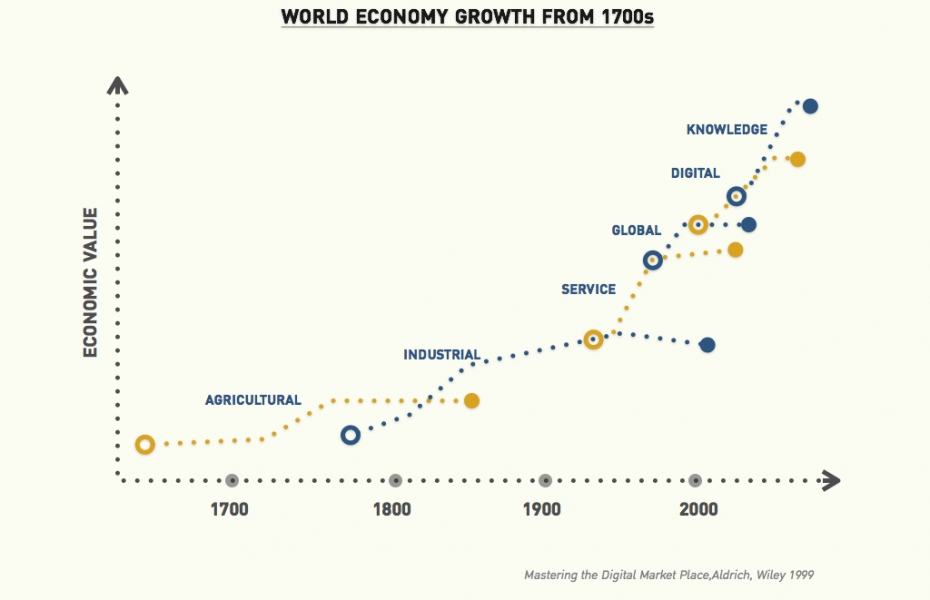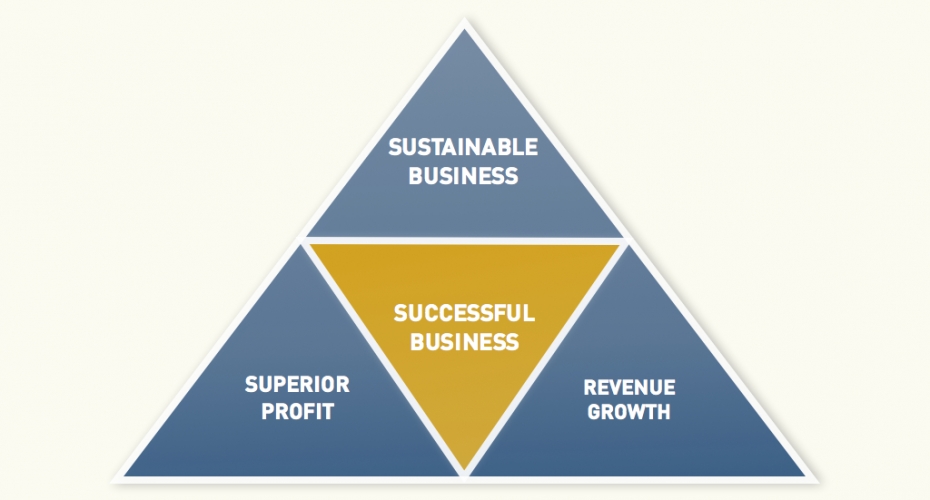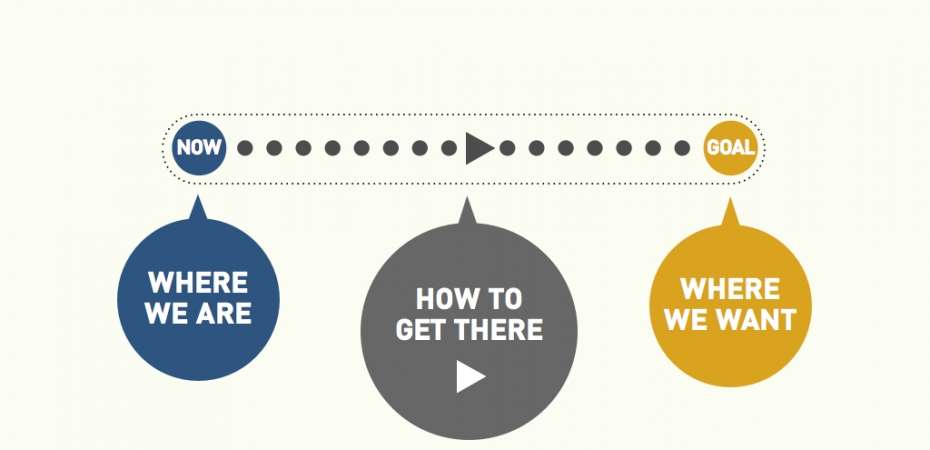BY DR. TANAI CHARINSARN
July 19, 2016
Business Development... Learn from the past... before studying the future...
Business managers often ask questions like, "Which business will profit us tomorrow?" and "How can we increase our business revenue?" If we have tried to study the economic evolution from history, many times we can predict or estimate the future situation. Understanding the natural course of events and the environment at that time will help us see the learning process and find opportunities to outperform competitors. Changes in the business environment are influenced by different eras and circumstances. This is what helps us assess the direction to make money for our business more easily.
Learn from the past... How does the history of the economy say it is?

AGRICULTURE ECONOMY (<1800S)
Going back to the time when prosperity didn't change rapidly as it does today, human needs were basic, consisting of food and shelter. People chose to settle near water sources, focusing on agriculture, farming, and cultivation. With the rapid population growth during that era, this drove significant growth in businesses related to food and consumption.
During this period, those engaged in agriculture were considered the wealthiest group, and prosperity was concentrated near water sources. We can see the cultural prosperity in various river valleys like the Nile, the Tigris-Euphrates, and the Yangtze River, among others.
INDUSTRIAL ECONOMY (1800-1900S)
When basic needs were fulfilled, humans started to focus on advancements in science and technology. This included areas such as electricity, machinery, mechanical engineering, and inventing things to produce enough to cater to the rapidly growing population. Those with knowledge in these fields began to accumulate wealth.
Prosperity was transferred to Europe and America, especially due to the vast empty lands and scarce water resources, which were not suitable for agriculture. We can see that subjects previously regarded as scholarly studies became matters of science, invention, and engineering. This led to the development of automobiles, railways, industrial factories, machinery, and textile manufacturing. Businesses in these areas could generate significant wealth. The shift occurred from agriculture to individuals with expertise in engineering, science, and invention.
- Key Success Factors vary across different economic eras -
SERVICE ECONOMY (1900-2000S)
When manufacturing no longer generated high value, people began to focus on their own satisfaction and had an increased demand for services. This led to the growth of service-oriented businesses, such as tourism, hotels, hospitals, finance, and banking.
GLOBAL ECONOMY (POST-WWII)
With many countries putting an end to war efforts and businesses booming around the globe, travel and communication became easier. The grouping of many nations allowed this era's economy to strive for global standards. Several businesses enhanced their wealth by producing and marketing their products and services globally, such as FedEx, CitiBank, McDonald's, and Starbucks. The rapid growth of digital business also occurred as the continuous decline in the price of digital equipment allowed businesses to spread their reach worldwide. Businesses like Google.com and Amazon.com represent this Digital Economy. These businesses still benefit significantly from their digital presence.
KNOWLEDGE ECONOMY (>2000s)
The value of money shifted towards knowledge-based industries like consulting, pharmaceuticals, and research and development companies. The changes in this era occurred at a much faster pace than in earlier economic eras due to the growth of internet technology, which allowed the global exchange of knowledge. Examples include Wikipedia.com, an online encyclopedia covering various topics worldwide. Some knowledge areas remain valuable in their own right, but having knowledge doesn't necessarily mean it's immediately usable. This typically applies to specialized fields like data analytics and investment risk assessment.
ATTENTION ECONOMY
In today's era, there is a reduced emphasis on the value of things. For instance, phenomena like Facebook, where attention may not always be on facts or reasoning but rather on creating trends, suggest that the focus has shifted to emotions and feelings. Creative thinking and thought leadership are also highly valued in this era because every business needs to create a unique proposition to capture market attention and societal approval. One should be cautious not to focus solely on generating trends and neglect the fundamental value of one's business. Even after attracting attention, the environment and people's preferences can change. In the end, your core business value might be overlooked.
So, what lies ahead, or is it time to return to the basics?
If you wonder whether we'll return to an era primarily focused on agriculture or not, it may not be that straightforward. You will notice that today's agricultural raw materials aren't showing a trend towards higher prices. Agriculture alone doesn't make people rich as it did in the past. Indeed, the agricultural commodities we see today are more valuable because they have been transformed, processed, and have added value through research and product development. However, it's unclear in which direction business development will head in the future. The key factor to always consider before entering any market is...
The change in each economic era affects those who adapt and, for the most part, leads to a backward impact. The focus on the core value of the environment during that period must be recognized and emphasized. That is the challenge of doing business in the future and in an era where everything is about creating trends but overlooking fundamental value. What you receive may not be as sustainable as you think.
BY DR. TANAI CHARINSARN
JULY 6, 2016
‘Success in Business’ The words that inspire dreams... Where are they truly measured?
The popular phrase that everyone, including businesspeople and entrepreneurs, often uses when it's time to give interviews or express their vision to the public, the media, or even their own team, is inevitable. The desire for success in their own business endeavors is something that cannot be avoided. When considering the same business, what can one do to achieve more success than others? And what is the measure of success in the global business world that many people dream of?

Definition of Successful Business
Profit Increasing or Decreasing: Is it Measurable?
Whether profit increases or decreases depends on various factors, both controllable (internal) and uncontrollable (external). Therefore, discussing business profits can be challenging, as it can result from superior management skills or simply luck.
Example 1: Thai Automotive Business in 2012
The government's support for the "first car policy" had a significant impact on the profits of car companies. These companies did not introduce any significant innovations or competitive advantages; instead, they benefited from government policies.
Example 2: Flooding in 2012
The flooding situation in Thailand affected various businesses, reducing their profits. This drop in profit was not necessarily due to poor management or price increases in response to rising demand for water. It is rather a result of external uncontrollable factors.
In summary, determining business success is not straightforward. The most commonly used metrics include:
-
Return on Invested Capital (ROIC): It's more critical when compared to competitors. It measures the ability of a business to generate profit concerning the amount invested.
-
Revenue Growth: Most people are concerned with measuring business success through revenue growth. However, this growth should be driven by profits generated by the business itself and reinvested for growth.
-
Sustainable Business: Sustainability is a key element of business success. To achieve sustainability, a business should focus on its core competencies and be in sync with market trends.
To achieve true business success, companies should evaluate and align their strategies based on their unique characteristics, taking into account their abilities, market dynamics, and global trends.
BY DR. TANAI CHARINSARN
JUNE 9, 2016
“SOMETIMES STRATEGIES MUST BE LEFT AS BROAD VISIONS, NOT PRECISELY ARTICULATED, TO ADAPT TO A CHANGING ENVIRONMENT.” - The Rise and Fall of Strategic Planning
HOW TO CREATE THE STRATEGY
In the past, strategists believed in and prioritized planning. What strategists looked at then was where the business was, where it was headed, and how it would get there. This approach has continued to evolve, with strategic planning requiring a wealth of data to be comprehensive and complete. From a single strategist, it has expanded to become a strategy development team. Each day, those working in this strategy development team gather and analyze data, including the current business status, market changes, and competition. This is to predict the future and determine the ultimate strategy that the business must employ.

This approach was subsequently viewed as ineffective and heavily criticized within the strategist community because the outcomes did not align with the expectations. This was due to two main reasons:
-
The plans designed were inherently flawed. Predicting the future is inherently uncertain, as it involves guessing what will happen. This leads to potential inaccuracies. Many changes often occur while strategic planning is underway, and these changes are challenging to predict, especially concerning shifts in competition.
-
The planners and the implementers were often disconnected. Often, those who create the plans may not have a deep understanding of the actual company's situation because they are not directly involved in the day-to-day operations. On the other hand, those implementing the plans may not fully grasp the origin of the plans or may not have been part of the planning process from the beginning. This disconnect can lead to a lack of motivation to make the plan succeed. Therefore, strategic plans began to be viewed as not adding value to the business.
Focusing solely on planning also caused issues, as the rapidly changing world today makes long-term predictions difficult. Many industries, such as the computer, mobile, and telecommunications sectors, are now unable to predict what the future holds in the next 3-5 years. As a result, many business long-term plans typically extend only about three years into the future, to be more adaptable to the swift changes in the global landscape. Notable recent examples of situations closely watched by strategists and investors include the U.S. Fiscal Cliff and the Eurozone crisis, both of which could significantly impact the global economy in the near future.
In response to these challenges, some strategists started to shift their focus to adapt their businesses continuously (Sense and Response) instead of long-term planning. This approach emphasizes observing how the business environment is changing and making decisions based on these observations. Although this type of strategy may not appear to be a traditional strategy, it helps businesses to continuously adjust to evolving situations. Notably, Japanese companies have been successful in implementing such strategies, adapting to changing circumstances and maintaining a competitive edge.
To succeed with this approach, organizations need to be able to gather information quickly about the market, customers, and competitors to respond promptly and effectively to changing events (Learning Organization). The benefit of this approach is that everyone in the organization plays a role in shaping the organization's direction. However, the downside is that the organization might sometimes change direction too frequently or inappropriately, making it less stable in the long run.
In summary, a good strategy should be designed to allow an organization to carry it out steadily for some time without changing it. It must perform well in the long term because changes occurring each time impact the work of everyone in the organization.



